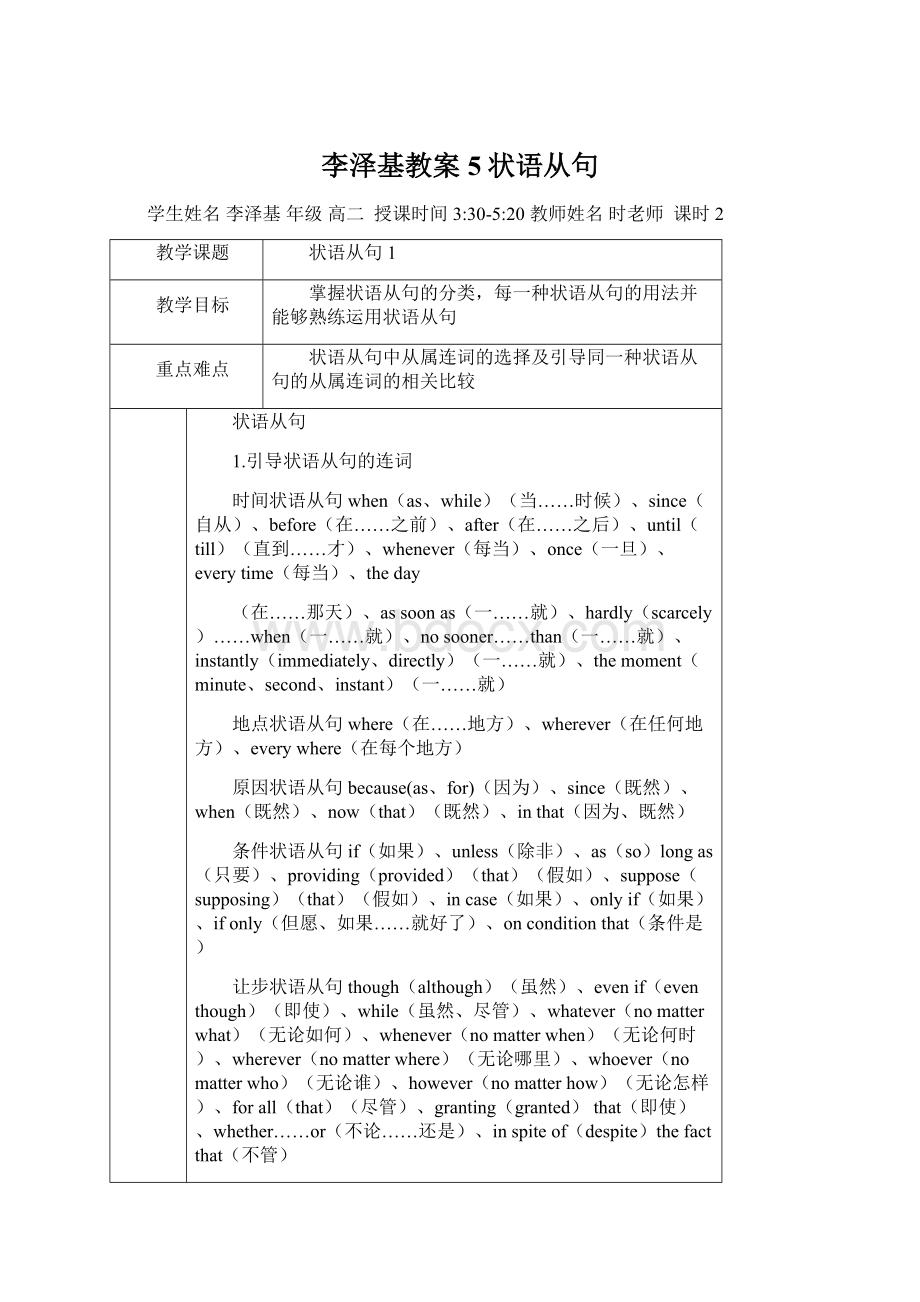李泽基教案5状语从句Word文件下载.docx
《李泽基教案5状语从句Word文件下载.docx》由会员分享,可在线阅读,更多相关《李泽基教案5状语从句Word文件下载.docx(16页珍藏版)》请在冰豆网上搜索。

比较状语从句than(比……)、as……as(像……一样)、notso(as)……as(不像……一样)、(not)thesameas((不)同……一样)、notsoas(不如)、(not)such……as((不)如……)
方式状语从句as(像……、犹如……)、asif(asthough)(好像、仿佛)、theway(……的样子)
2、时间状语从句(表示时间的状语从句)
①when、whenever、while和as
when意为“当……时候”,表示某个具体的时间。
所引导从句的动作或是与主句的动作
同时发生,或是先于主句动作。
when可指一段时间也可指一点时间(即时间点);
既可表示一时性动作又可表示持续性的动作。
whenever意为“每当”,指的是任何一个不具体的时间。
as意为“当……时候”更侧重于“一边……一边……”,as还可表示“随着”。
while表示一个时间段,只能表示持续性的动作或状态,不能表示一次性或短暂性的动作。
例如:
Heenteredthelecturehallwhen(as或while)thelecturerwasspeaking.(指一段时间)
While(as)hewasstudying,hisbrotherwassleeping.(指一段时间)
When(as)hearrives,Iwillinformhimofit.(指一点时间不能用while)
Iwasdoingmyhomeworkwhensuddenlythetelephonerang.(指一点时间)
②before和after
before意为“在……之前”,表示从句的动作发生在主句动作之后。
after意为“在……之后”,表示从句的动作发生在主句动作之前。
Hehaddonegoodpreparationsbeforehewenttocollege.
Afterhehadtriedmanytimesandfailedintheend,hegaveup.
③until和till
这两个词都表示“直到……、到……为止”。
表示一个动作持续到某一时刻为止。
二者用法相近,但在句首时只能用until。
Hewaitedathomeuntil/tillitstoppedraining.
Untilallthelightsinthestreethadbeenoff,theboywenthome.
A、not……until可用于强调句中,这种强调结构只能用until(till)不用before。
Itwasn’tuntilteno’clockthatthelazyboygotup.
B、not……until可以位于句首表示强调,运用倒装结构,这时不可用before。
NotuntilyesterdaydidIfindthemissingbagathome.
Notuntilhewaspunisheddidtheboyrealizehisfault.
=Itwasnotuntilhewaspunishedthattheboyrealizedhisfault.
=Theboydidn’trealizehisfaultuntilhewaspunished.
④since
A、since表示“自从……”,所引导的从句一般要用非延续性动词,主句多用延续性动词和完成时态。
Hehasworkedatthiscollegesincehegraduated.
B、since引导的从句若用延续性动词或状态动词的过去时,则表示该动作或状态的完成或结束。
Ithasbeenfiveyearssinceheworkedhere.他不在这工作已经五年了
Sincehelivedhere,Ihavelosttouchwithhim.(=Sincehelefthere……)自从他不住在这儿,我就和他失去了联系
Sincehewasatschool,hehasworkedinthatcity.(=Sincehewasn’tatschool……)自从他下学,他就在这个城市工作
⑤hardly(scarcely)……when(before)和nosooner……than
这几个连词词组都表示“一……就……”,强调主句和从句的动作相继发生。
此结构有以下两个特点:
一是主句谓语动词用过去完成时(haddone的形式),从句谓语动词用一般过去时;
二是否定副词hardly、scarcely和nosooner位于句首,主句用部分倒装结构,助动词had提到主语前面。
Hardlyhadtheyfalleninlovewitheachotherwhentheygotmarried.
=Theyhadhardlyfalleninlovewitheachotherwhentheygotmarried.
NosoonerhadIarrivedhomethanitrainedheavily.
⑥assoonas、directly、instantly、immediately和themoment
这几个连词都表示“一……就……”,表示从句动作一发生,主句动作立刻发生。
名词词组theinstant、themoment、theminute、thesecond、everytime、anytime、nexttime、thefirsttime、thelasttime、theday、themonth、theweek、theyear、themorning、theafternoon等也可作为连词引导时间状语从句。
Hewenttotheofficeimmediatelyhereceivedthenotice.
AssoonasIarrive,Iwillmakeatelephonecalltoyou.
Themoment(minute/second/instant)hesawherhefellinlovewithherdeeply.
EverytimeImeether,shewillsmiletome.
Hegotmarriedthesummerhegraduatedfromcollege.
3、地点状语从句(表示地点的状语从句)
地点状语从句由where、wherever和anywhere引导,位置较灵活可放在主句后也可放在主句前。
where指“在某个地方”、wherever指“在任何地方”、everywhere指“每个地方”。
Wherethereisawill,thereisaway.
Putthebookbackwhereitis.
Whereverwego,ourparentswillmissus.
Anywhereyougo,Iwillaccompanyyou.
4、原因状语从句(表示原因的状语从句)
①because、since、as和for
A、because表示原因时语气最强,常用来回答why引导的疑问句。
用于强调句强调原因时只能用because不可用其它三个词,because可和强调词just、only以及not连用。
because从句一般位于主句后,也可放在主句前面表示强调。
B、since语气比because弱,表示一种附带的原因或是对方已知的事实,表示一种显然的理由,相当于汉语的“既然”,引导的从句常放在句首。
since可用于省略句中(如since、so“既然如此”),其他三个词不能用于省略句中。
C、as语气较弱,只是对主句的附带说明,表示不言自明的原因或是已知的事实。
as引导的从句通常放在主句前。
D、for表示原因时语气最弱,for引导的从句并不是主句行为的直接原因,只起到一种补充说明的作用。
只能放在主句后面,不可位于主句前,且用逗号同主句隔开。
例如
—Whydoyoudisagreetotheproposal?
—Becauseitisunpractical.(只能用because)
Hecutclassjustbecausehedidn’tlikemath.(只能用because)
Itwasbecausehereceivedhigheducationthathehadmoreopportunitiesthanothers.(只能用because)
Becausehebrokethetrafficrule,hewasfined.(表示强调)
Wemustgetridofcarelessness,foritoftenleadstoerrors.(位于主句后用逗号同主句隔开)
Sinceyouhavenotimetospare,Iwillturntoothersforhelp.
AsIgetlost,Idon’tknowhowtogoback.
②now(that)、inthat
这两个连词意思相近意为“既然、由于”。
nowthat位于句首,inthat位于句中。
Now(that)youhavedonegoodpreparations,youneedn’tfeelworried.
Allofuslikehiminthatheisveryhumorous.
5、条件状语从句
①if和unless
if表示正面条件意为“如果”,unless表示反面条件意为“除非、如果不”相当于ifnot,一般情况下可以互换。
Ifitissunnytomorrow,we’llgohiking.
Youwillbelateunlessyouhurry.
Ifyoudon’thaveagoodcommandofEnglishgrammar,youwon’tstudyEnglishwell.
=UnlessyouhaveagoodcommandofEnglishgrammar,youwon’tstudyEnglishwell.
②provided/providing(that)、suppose/supposing(that)、so(as)longas、onconditionthat、incase、assuming(that)、given(that)等。
Supposing/supposeitrains,whatshouldwedo?
Providing/provided(that)youcankeepthesecrettoyourself,Icantellyouaboutit.
Assuming(that)anearthquaketookplace,whatwouldhappentothevillage?
IncaseIcan’tarriveontime,youcangofirstwithoutme.
③onlyif和ifonly
onlyif表示“只要”,only起到强调的作用,引导的从句用陈述语气;
ifonly引导的从句要用虚拟语气,意为“但愿……、如果……就好了”。
Onlyifyourespectothers,you’llberespected.
IfonlyIwereamillionaire.
IfonlyIhadfollowedhisadvice.
6、让步状语从句
让步状语从句表示“虽然、尽管、即使”等含义,不可和but同时使用,两者只能用一个。
但可和yet、still、nevertheless等连用。
①although、though、eventhough和evenif
这几个词或词组都表示“虽然、即使、尽管”。
eventhough和evenif语气较强而although和though相对较弱,although较正式而though较通俗。
让步状语从句可位于主句前也可位于主句后。
Althoughourparentsoftencriticizeandevenbeatus,westilllovethem.
ThoughIlikelisteningtomusic,Ican’tsing.
Eventhough(if)heisrich,yetheisn’thappy.
Thoughmostofusareagainstit,neverthelessIamforit.
在让步状语从句中though和although常可互换,但在下列几种情况下只能用though不能用although。
A、though可和even连用表示强调而although不可以。
Eventhoughtheprocessisfullofdifficulties,theresultiswonderfulandsatisfactory.
B、though可同as连用构成asthough,相当于asif表示“好像”。
Itlooksasthoughit’sgoingtorain.
C、though可用于倒装式的让步状语从句中,相当于as,而although则不可以。
Toughthoughthesituationis,Iwillfaceuptoit.
D、though作为副词或等立连词时表示转折,意为“然而、却”,不可用although。
HespeaksEnglishquicklythoughcorrectly.
Itisafact,though.
②whether……or(not)
从属连词whether……or意为nomatterwhether……or……,引导让步状语从句提供两个对比的情况,表示“不管”。
Whetheryoulikeitornot,you’llhavetodoit.
Whetheryougowithmeorstayathome,Iwillgo.
Whetherornotitrains,themeetingwillbeheldontime.
③whatever、whoever、whichever、whenever、wherever和however
这几个词除可引导名词性从句,也可引导让步状语从句。
相当于nomatterwhat、nomatterwho、nomatterwhich、nomatterwhen、nomatterwhere和nomatterhow表示“无论什么、无论谁、无论哪一个、无论何时、无论何地、无论如何”但“nomatter+特殊疑问词”只能引导让步状语从句,不能引导名词性从句。
Whateveryousay,Iwon’tbelieveyou.(=nomatterwhat)
Whoeverrespectsus,weshouldrespecthim.(=nomatterwho)
Whenevershegetsangry,hewillcheerherup.(=nomatterwhen)
Whereveryougo,Iwillkeepyoucompany.(=nomatterwherever)
Whichevercoloryouchoose,thetiewillmatchyourcoatwell.(=nomatterwhich)
Howevercarefulweare,wewillerr.(nomatterhow)
让步状语从句中的倒装
though引导的让步状语从句可以运用倒装结构而其它从属连词则不可以。
在倒装结构中,though可用as或that代替。
但用as和that引导让步状语从句时必须倒装。
倒装形式主要有以下几种。
A、名词+though(as、that)+主语+be动词
Managerthough(as、that)heis,heisverymodest.
这时作表语的单数可数名词放在句首时,名词不能同冠词连用。
B、形容词+though(as、that)+主语+谓语
Strongthoughyouare,youcan’tliftit.
这时作表语的形容词前不能添加任何表示程度的副词。
C、副词+though(as、that)+主语+谓语
Hardasheworks,hewasunabletomakegreatprogress.
D、原形动词+though(as、that)+主语+助动或情态动词
Failmanytimesashedid,heneverlostheart.
Searchthoughtheymight,theycan’tfindanybodyinthehouse.
E、现在分词+though(as、that)+主语+be动词或助动词
Rainingasitis,I’mgoingtovisityou.
Living,ashedoes,aloneinthemountain,hefeelspleased.
F、过去分词+though(as、that)+主语+be动词
Praisedashewas,heremainedmodest.
但上述有些结构并非总是表示让步,名词或过去分词放在句首时也可以表示原因。
Childasheis,hedoesn’texperiencesomesocialproblems.
Bornasheisinarichfamily,hegrowsupbetterthanothers.
Tiredashewas,hestoppedworkingandwenttobed.(原因)
Tiredashewas,hecontinuedtowork.(让步)
7、结果状语从句
①so……that和such……that
这两个短语表示“如此……以至于……”,常用的结构如下。
so+形容词(副词)+that
so+形容词+a(an)+可数名词单数+that
such+形容词+复数名词+that
such+形容词+不可数名词+that
such+a(an)+形容词+可数名词单数+that
Theboyissoyoungthathecan’tgotoschool.
Hehadsomanypaperstodothathestayeduplate.
IhadsolittlemoneythatIcouldn’taffordthatcar.
Heissuchacleverboythateveryonelikeshim.
=Heissocleveraboythateveryonelikeshim.
②sothat、so和sothat
这三个词也可引导结果状语从句,也可理解为sothat中的so或that可省略一个。
sothat最常见,so和that多用于口语中。
sothat引导的结果状语常用逗号同主句隔开。
Hegotuplate,sot